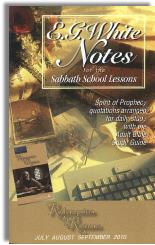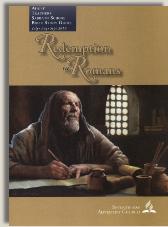|
||||||||||||||
Commentary on "All Have Sinned"
Day 2: Sunday, July 11, 2010 - Not Ashamed of the Gospel
Overview
This lesson considers two key texts that changed Martin Luther’s view about the gospel and prompted the Reformation, restoring the purity of the gospel in the Christian church. Nevertheless, the lesson doesn’t offer this historical perspective about the meaning and importance of these texts; instead it focuses on three words: gospel, righteousness, and faith—not in a comprehensive manner but promising future developments in the weeks that will follow.
Observations
Because of this approach, the current writer feels limited in regard with providing a meaningful commentary, at this stage being able, due to the short material provided, just to direct the reader toward reading future lessons with some questions in mind. These questions will refer specifically to the three words highlighted by today’s lesson.
The author relates the Gospel—good news—to the coming of Messiah, Christ, and salvation by faith in Him. This belief is tied specifically Christ’s righteousness (the second word highlighted by the study) which we are told is where we find salvation, not in our righteousness and not even in the law. While these things are positive in themselves, in the larger context of Adventist theology with its specific identification of Sabbath-keeping as the seal of God, this lesson does not address the Adventist understanding that the law has a role in retaining salvation.
According to the Adventist perspective about end times, failure to keep the Sabbath against all economic and social odds will result in a loss of salvation. What we see here affirmed is the truth that “We are saved by grace, not by works”—in other words, not by law-keeping. This affirmation does not eliminate the erroneous view which brings works through the back door into the scheme of salvation by affirming that “we remain saved by works”, by law-keeping. Failure to accomplish the necessary condition of keeping all the commandments of God, especially Sabbath, is tantamount of losing salvation. In reality, this belief is another way to say we are not saved by works, but we can be lost because of lack of works.
While this day’s lesson is just an introduction, the reader will do well if he will look in future lessons to see whether the author attributes retaining salvation to works and obedience to the law. It’s encouraging to hear that we do not find salvation in the law, but the unresolved issue raised by the Adventist end-time scenario which gives of law a role in our retaining salvation is left on the shelf.
The other word, righteousness, while touched lightly in the previous treatment of gospel, is rightly seen as being provided by God. This is in harmony with the idea that righteousness comes from God from outside of us. Not only does it not come from inside us, but it is exclusively outside of us. It is never our personally attaining righteousness, even with the help of God. This understanding is one of the breakthroughs Luther made when he restored the gospel in the 16th century. This truth is what the Reformation made clear: no internal transformation, no works—nothing from inside man can play a role in justification which is by faith, apart from works (Romans 3:28, 4:6).
Historically Adventists have seen God’s righteousness, on which salvation depends, as being partly external from us and partly our own internal transformation. Future lessons will clarify whether this view is shared by the author of the lessons. At this moment, the author tells us that “this is the only righteousness good enough to bring us the promise of eternal life.” As far as it goes this affirmation points in the right direction, but still it leaves open the question if it goes far enough. Is this righteousness sufficient to make sure for the believer the promise of eternal life, or is this promise conditioned or contingent on his future behavior? It is true that Christ’s righteousness is necessary for bringing the promise of eternal life; the question is if it is sufficient to seal the believer’s eternal destiny. In the Adventist understanding, Christ’s righteousness is necessary but not sufficient to “close the deal”. Future lessons will make clear if the author departs or not from this classical understanding of the Adventist doctrine.
Perhaps the most important and relevant word in this lesson is “faith”. While giving a short preview of this word by quoting the original Greek words used for faith, it remains unclear whether or not the author includes “works” in this definition of faith. Faith is contrasted in the Bible with works when it comes to salvation, excluding works entirely from the way sinners are justified (Romans 3:27-29). While works always accompany a genuine faith (see James 2 for a treatment of what constitutes true faith), works are not part of faith. But there is a subtle way in which works are reintroduced in the schema of justification by introducing them into the definition of faith.
While directing readers to future lessons in order to see if the author gets the gospel right, at this moment the present writer finds it proper to provide a sneak preview of the author’s definition of faith taken from 19 July, Monday, lesson 4.
The faith of Jesus Christ is here doubtless faith in Jesus Christ. As it operates in the Christian life, faith is much more than intellectual assent; it is more than just an acknowledgment of certain facts about Christ’s life and His death. Instead, true faith in Jesus Christ is accepting Him as Savior, Substitute, Surety, and Lord. It is choosing His way of life. It is trusting Him and seeking by faith to live according to His commandments.
Especially from the last sentence the idea of defining faith as trusting AND being obedient to the commandments becomes clear. While the author devoted the entire lesson 6 to talking about faith, even at the early stage of lesson 4 his muddled definition of faith including works becomes apparent.
The end of today’s lesson asks some important questions which imply that lack of assurance of salvation is related to behaviors that accompany the profession of faith. The final question in the sequence suggests strongly that the way in which the believer can gain assurance of faith is by making the right choices and exemplifing a behavior fitted with his profession of faith. Instead of rooting the assurance of salvation in God’s grace and his gospel, the author decides to direct people toward themselves and their behavior. It’s hard to understand how this is truly good news, the gospel about which Paul was not ashamed, because it was God’s power of salvation and not man’s power and ability to cooperate with God. The gospel is the power for salvation because it proclaims a righteousness sufficient and efficient apart from human works and human involvement, offering a solid ground under the believer’s human feet, not the shaking grounds of human frailty.
Summary
- Gospel, righteousness, and faith are all involved in our salvation in some way.
- The lesson says we find our salvation not in law but in Christ’s righteousness. This lesson fails, however, to specify whether or not “Christ’s righteousness” involves internal righteousness in us as part of “staying saved”.
- Righteousness, as it is explained in Romans, is entirely the external-to-us righteousness of God. It is not “Christ’s righteousness worked out in us”, as traditional Adventism has taught. Our salvation and security do not depend upon or even include our sanctification.
- Faith is necessary for salvation, but the lesson does not clarify whether or not the author’s definition of “faith” includes our obedience. In a later lesson the author reveals that he believes “faith” includes living “according to His commandments”. Faith that leads to salvation is entirely a gift of God (Ephesians 2:8-9) and is never defined by any behavior of ours.
- Finally, the gospel is never defined in the Bible as “Christ’s righteousness”. Rather, Paul defines it in 1 Corinthians 15:1-4 as this: Jesus died for our sins according to Scripture, was buried, and rose on the third day according to Scripture. These objective facts are the gospel that Paul said he would preach exclusively (1 Cor. 2:2). Christ’s righteousness is what He imputes to us when we place our faith in the crucified and risen Savior. Christ’s righteousness is the result of the gospel in our lives, never the gospel itself.
Copyright 2010 BibleStudiesForAdventists.com. All rights reserved. Revised July 9, 2010. This website is published by Life Assurance Ministries, Glendale, Arizona, USA, the publisher of Proclamation! Magazine. Contact email: BibleStudiesForAdventists@gmail.com.
The Sabbath School Bible Study Guide and the corresponding E.G. White Notes are published by Pacific Press Publishing Association, which is owned and operated by the Seventh-day Adventist church. The current quarter's editions are pictured above.
Official Adventist Resources
Standard Edition Study Guide Week 3
Teacher's Edition Study Guide Week 3
Easy Reading Edition Study Guide Wk 3
Search the Complete Published Ellen G. White Writings


